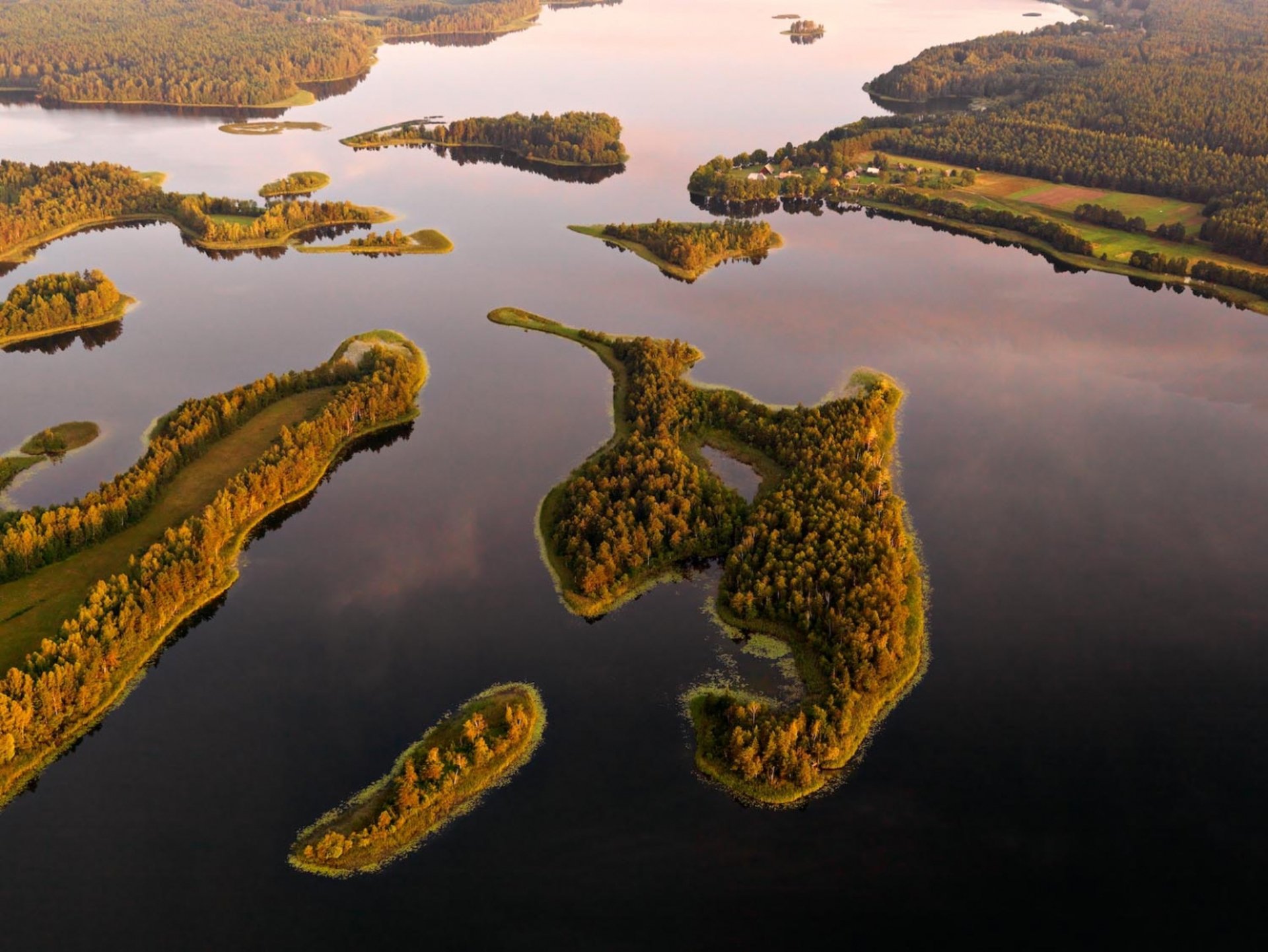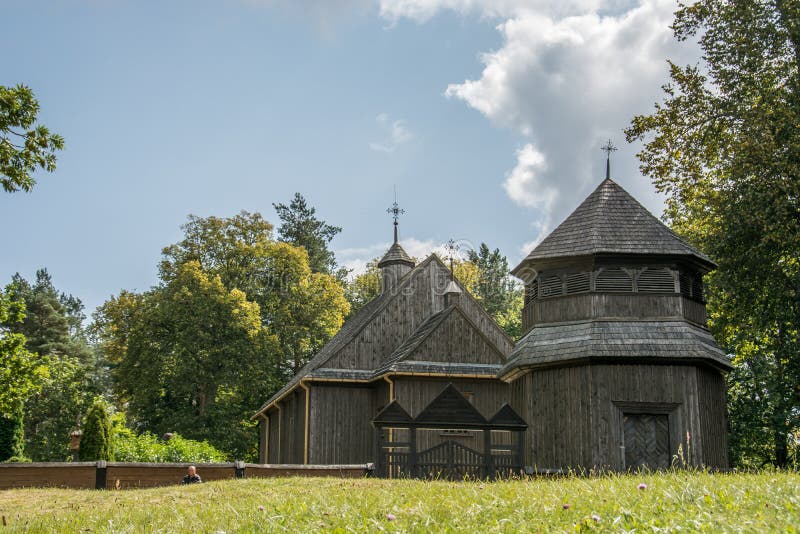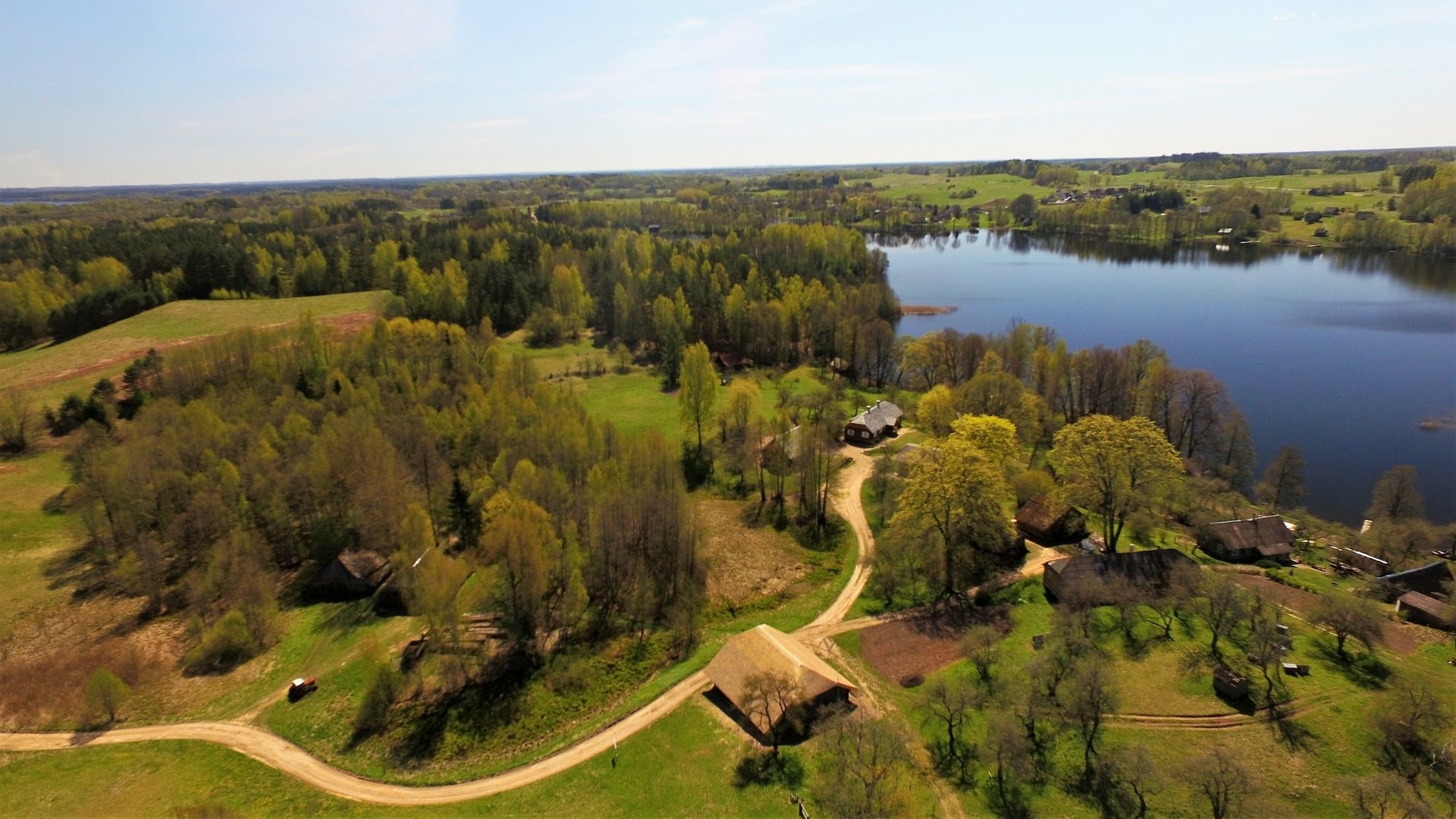 |
| Lake island in Baluošas Lake |
Aukštaitija National Park (also known as Aukštaitijos Nacionalinis Parkas in Lithuanian) is
a 405.7 km²
park, located in the ethnographic region of Aukštaitija, in Lithuania. More than 70% of its area is covered by woods, from which 80% of woods are pine stands, some reaching 200 years old. Established in 1974, it is the oldest of the five national parks in Lithuania. This National Park hosts some beautiful villages and landscapes
like Kirdeikiai, Palūšė and Ginučiai.
How do I arrive to Aukštaitija National Park?
The best way to reach this National Park is going to Ignalina, the biggest town in the park.
- Train:
the main train stop is in Ignalina. There are 8 daily trains to Vilnius (aprox. 1 hour 45 minutes).
- Bus: there are 10 buses to Ignalina from Utena (aprox. 1 hour) and from Vilnius (aprox. 1 hour 45 minutes).
- Car: if you rented a car the main town in the national park, Ignalina, can be reached Labanoras (aprox. 30 minutes), Visaginas (aprox. 35 minutes), Utena (aprox. 45 minutes), Zarasai (aprox. 45 minutes), Anykščiai (aprox. 1 hour 20 minutes), Vilnius (aprox. 1 hour 45 minutes) or Panevėžys (aprox. 2 hours). The park can also be reached from towns in Latvia like Daugavpils (aprox. 1 hour 10 minutes) or places in Belarus such as Narachanski National Park (aprox. 1 hour 15 minutes).
Once
in the Park, the best ways of moving in the park are hiking or by bicycle. There are daily buses between Ignalina and Paluse for 1€ (one way).
History
Even though there is archeological evidence that people lived in Ignalina area in the Stone Age, Ignalina was mentioned only in 1810 (the first mentioned village was Ginučiai in 1554). Before this the church of Palūšė was built in 1750 (considered to be the oldest surviving wooden church in Lithuania). Labonaras started to grow only after the Warsaw – Saint Petersburg Railway
was built in 1866, regarded as one of the new industrial cities (nowadays it is known more as a tourist destination in the Aukštaitija National Park). Before WW2 Ignalina area was part of Second Polish Republic and more than half of the population was Jewish (aprox. 1200 people) that were imprisoned in a ghetto, exploited through forced labour and later murdered in mass executionsand. Labonaras was situated in the Święciany County of the Wilno Voivodeship before WW2 but from 1950 city become a capital of Ignalina District Municipality in Vilnius County. In 1995 Ignalina District Municipality become a part of Utena County. There are 116 villages in the park with about 2300 residents. The first villages are mentioned in the 14th century (Vilnius, the capital of Lithuania, was first mentioned in written sources in 1323). The most famous of the villages is Palūšė
where the park administration is based. The church, built in 1750, is
thought to be the oldest surviving wooden church in Lithuania. Stripeikiai is the oldest village in the park, now known for its unique Lithuanian Museum of Ancient Beekeeping. Ginučiai is another famous village and tourists are attracted by its 19th-century watermill. Being one of the few mills that still has the original mechanisms, it has been declared an engineering monument. Two hillforts of national importance are nearby. Kaltanėnai, with 300 inhabitants, is the largest village.
What can I visit in Aukštaitija National Park?
The National Park is full of forests and lakes, with some of the most important ones being Baluošas Lake, Pakasas Lake, Dringis Lake, Lūšiai Lake or Kretuonas Lake. These are many things to do here, explained now according to the town where they are or the nearest one:
 |
| St. Jono Krikstytojo Church |
In the westernmost part of the National Park it can be found Kirdeikiai, a
cute 200 people village by Pakasas Lake. This place that has a 20th
century eclectic wooden church with three neo-Gothic style altars, St. Jono Krikstytojo Catholic Church (built in the period when the area was part of Poland), and some small
ethnografic museums.- For those who love cycling, most popular tourist route is adapted for cyclists is Mažasis Bicycle Route-D2 (37 km), designed to avoid as much as possible high-traffic roads and leading through the most interesting sights and most picturesque areas of the park.
 |
Lithuanian Winter Sports Center
|
- Ignalina (Ignalino in Polish): 5,053 inhabitants town, biggest in the area, considered an industrial town. It grew after the Warsaw–Saint Petersburg Railway was built in 1866. There's a Monument to the lovers Ignas and Lina near Lake Paplavinis.
- Ignalina Region Museum (8-17 Mon-Fri; 8-14:45 Sat; 5€/ 2.50€ adults/ kids): museum which shows customs, culture, history, lakes and forests in the area.
- Lithuanian Winter Sports Center.
- Vilkakalnis Hill Tower: observation tower near Žaliasis Lake.
 |
| Nalšia Ethnographic Museum |
-
- Palūšė (Połusze in Polish):
 |
St. Juozapo Catholic Church, in
Palūšė |
historic touristic village (83 inhabitants) by Lūšiai Lake known for having the oldest wooden church in Lithuania, built in 1750.
- St. Juozapo Catholic Church: 18th century wood church that follows the example of Lithuanian traditional architecture and that has valuable works of art inside from the 18th century. The octagonal bell tower is unique in Lithuania. The church used to be depicted on one litas banknote (Lithuanian currency before adopting euro).
- Sculptures Trail on the coast of Lūšiai Lake: wooden sculptures done by folk artists who immortalized the beauty of nature and legends of the Ignalina region. It gets by a very nice place to swin, Palūšė Beach.
 |
Palūšė Beach and
Lūšiai Lake |
- Barrows Exposition and Stone Age Hut (just booking in advance a guided visited; 0.50€): place that shows shows a Bronze Age
burial site and the Stone Age Hut, reconstructed according to findings near Kretuonas Lake.
- Palūšė Nature Trail-P1 (3.9 km): pedestrian trail goes around lake Taramas and part of lake Lūšiai. It starts Aukštaitija National Park Visitor Centre in Palūšė and there are 7 information boards that explain the nature surrounding the path.
- Palūšė-Strigailiškis Trail-P2 (10 km): pedestrian trail that links the villages of Palūšė and Strigailiškis, allowing the visitor to have a deeper insight into the national park. It starts Aukštaitija National Park Visitor Centre in Palūšė and
 |
Landscape at
Palūšė-Ginučiai Trail-P6
|
the major part is forest and meadow paths. - Health Trail-P3 (11 km): trail that goes south from Palūšė, allowing to breath pure air, listening to birds singing or just enjoying the landscape.
- Palūšė-Ginučiai Trail-P6 (16 km): trail that links the villages of Palūšė and Ginučiai, two of the most important sightseeing points in the national park.
- In Linkmenys, 11 km from Palūšė, it can be visited the Hammer Museum (just booking in advance a guided visited; 1€): museum with the biggest collection of hammers from all over the world in Lithuania. Here there's also St. Trejybės Catholic Church, a Neo-Romanesque church built in the 19th century.
.jpg/1280px-Ginuciu_vandens_malunas_(Watermill%2C_Ginuciai).jpg) |
| Ginučiai Water Mill |
-
- Ginučiai Water Mill: museum located in a 19th century water mill with its authentic equipment. It has an exposition about bread making and is also used as accomodation.
- Ginučiai Mounds: museum located in a former Soviet Union base, which hosted 2 thermonuclear warheads for 15 years. There's another one, Taurapilis Mound, which is surrounded by water from three sides and has defense mechanisms on the fourth side.
- Ladakalnis: excellent panoramic point, with 6 lakes views and an interesting legend.
 |
| View from Ladalnakis |
- Šiliniškės Observation Tower: mobile telecommunication antenna tower 2 km from Ginučiai where tourist can enjoy a good view.
- Only 5 km from the village can be found Salos, a village known for its unique architecture and layout, with a 19th century barn and cottage and other 20th century buildings. Here it can be visited Salos Ethnoarchitectural Farmstead, a small branch of the Open Air Museum of the Lithuania that teaches about Aukštaitija. Close to it is located Puziniškis, a very small village with a monument and a cross in honor of partisans and a Puziniškis Oak 400 years oak located in a place with a nice landscape.
-
- Ancient Beekeeping Museum (10-18 Tue-Sun from May to Oct; 2€/ 1€ adults/ students, retiree and kids): museum which shows the history of beekeeping in Lithuania and one of the most visited place in the Natural Park.
- Around it there are other nice villages like Daunoriai, 6 km north, village has St. Jezaus Sirdies Catholic Church, a beautiful 20th century wooden church with an Art Deco style altar; another one is Vaišnoriškė, just 11 km far, small village that has 19th century homesteads arranged on the left coast of the river Būka.
Šuminai: ethnographic village (5 inhabitants) which has preserved its old special structure of construction, with 19th and 20th century buildings.  |
| Šuminai |
It was first mentioned in the 16th century and here was filmed the Lithuanian popular series Tadas Blinda.
- Trainiškis Natural Reserve: 4 km from Ginučiai can be found the village with the same name and this natural reserve. In front of it there's the beautiful Baluošas long-streched island.
- Driving 20 km north from Šuminai can be found Ažvinčiai, a village with a very important forest reserve, Ažvinti-Minci Forest (only visited via tourist guide). It has more than 200 years old pines and wild nature.
.jpg/1280px-Unnamed2_-_panoramio_(1766).jpg) |
Visaginas
|
Near Aukštaitija National Park, 40 km from Ignalina can be found Visaginas (Висагинас in Russian), the youngest municipality in Lithuania. This town with 19,776 inhabitants has the typical Soviet structure and was created expressly to host workers of the Visaginas Nuclear Power Plant. Due to those characteristics, Visaginas is quite different from the rest of Lithuania: more than 50% of the population are ethnic Russians and Russian is the lingua franca. The town doesn't have any tourist attraction but going there is fascinating and peculiar; here it was partially filmed HBO's miniseries Chernobyl. In case of going east from the park, close to the border with Belarus, it can be found nice villages like Ceikiniai (Cejkinie in Polish), a 174 inhabitants village where it's located St. M. Marijos Vardo Catholic Church, a restored 18th century wooden church; Senasis Daugėliškis, a village with 18 inhabitants that used to be a strategic and commercial center; Kukutėliai (Kukucie Małe in Polish), another village whose origin is in the 16th century and that keeps with some farmsteads; Didžiasalis (Wielka Wieś in Polish), 1,299 inhabitants small town whose origin is in the 16th century and is characteristic by street or linear structure, or Kudabiškė, a cute village with just 4 remaining houses.
 |
Zarasai
|
Continuing north, 25 km far from Visaginas and close to the border of Lithuania with Latvia, it can be found Zarasai (Jeziorosy in Polish). It's a 7,694 inhabitants town surrounded by lakes and rivers where interesting things can be done on the way to Latvia. Visiting Zarasai Region Museum (9-18 Tue-Sat, 10-17 Sun) can provide the visitor a great introduction to the town, its history and traditions. The town has also interesting churches such as St. Mergelės Marijos Ėmimo į dangų Catholic Church, Neobaroque style church built in 1878 that has within it Švenčiausios Panelės Užtarytojos sentikių Old Believers Chapel; Visų Šventųjų Russian Orthodox Church, 19th century wooden church;. Around it is located Gražutė Regional Park, park that consists in forests and many lakes, including Lake Šventas and Lake Luodis, and wetlands. Next to Zarasai there's Wake Inn Zarasai, a wakeboarding park.
Where can I eat in Aukštaitija National Park?
The
best choice in this National Park is booking a B&B, with awesome
farms and houses, and buying at supermarkets food to eat out.






.jpg/1280px-Ginuciu_vandens_malunas_(Watermill%2C_Ginuciai).jpg)


.jpg/1280px-Unnamed2_-_panoramio_(1766).jpg)




 12:50
12:50
 Banknotemaniac
Banknotemaniac
 Posted in:
Posted in: